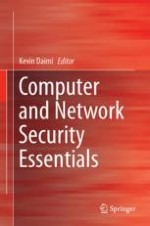2018 | OriginalPaper | Chapter
34. A Cognitive and Concurrent Cyber Kill Chain Model
Authors : Muhammad Salman Khan, Sana Siddiqui, Ken Ferens
Published in: Computer and Network Security Essentials
Publisher: Springer International Publishing
Activate our intelligent search to find suitable subject content or patents.
Select sections of text to find matching patents with Artificial Intelligence. powered by
Select sections of text to find additional relevant content using AI-assisted search. powered by
